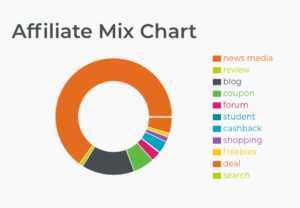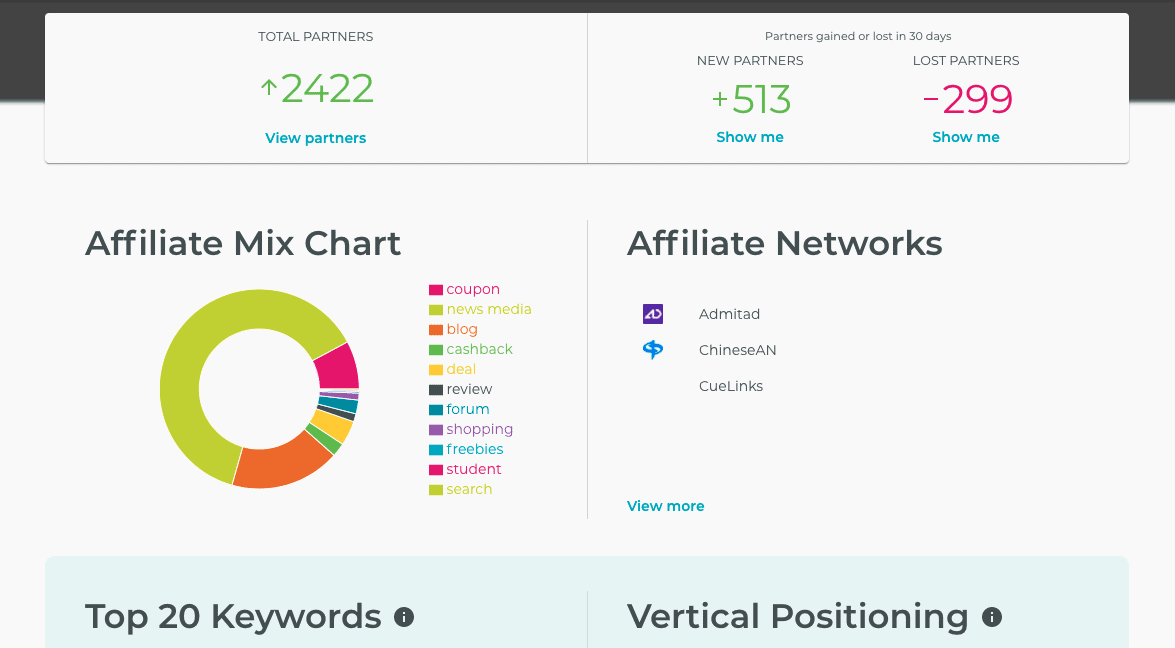How Publisher Discovery makes the process easier
Our vision in developing Publisher Discovery has been to simplify one of the toughest tasks in affiliate management - to recruit affiliates. Starting from zero several years ago, the initial tool was simply a version of an SEO platform, and relatively limited. However, it broke new ground in providing transparency for affiliate managers and was used by several major global brands and networks.
Now we have applied AI and machine learning to streamline the process and really make recruiting a breeze. This automation is what drives our free tools in the search box on the home page and Chrome extension.
So whether you're starting a new program (as so many smaller online retailers did over the last year or so) or re-energising an existing program we thing Publisher Discovery is your ideal toolbox to make life easier. We've collected together some of the best advice from our partners and friends in the industry to help further.
Set Your Objectives
While it's true that setting up an affiliate program isn't a 'one and done' task, it's also important to have objectives beyond a wooly one of 'get more sales'.
The overall business objectives need to feed into the affiliate activity. So if the goal for Q4 is to increase website sales revenue by 15% yoy, then an appropriate volume needs to be applied to affiliate activity.

In that mix you'll also need to allow for any global changes as we all saw in the huge shift online from 2019 to 2020. You also need to factor in any changes in affiliate landscape; that period also saw an influx of influencers and other content publishers the affiliate revenues in their promotional mix.
That goes for new entrants and to mature affiliate programs. So, that may well mean you'll need to look at recruiting new content affiliates and Publisher Discovery is the ideal tool for searching for them - take a look at your own vertical sector in Finding Affiliates.
'Affiliate' is now a term that's increasingly being understood by the C-suite and is getting significant attention at board level. If you're tasked to grow affiliate sales you'll want to recruit affiliates - at scale. But, be aware that's not just about spamming as many prospect publishers as possible as we discuss here!
Set the Program up Correctly
This can be quite daunting, deciding how to figure your program if you're new to the sector. As with all marketing you should base your decisions on research. Even for established programs, it's worth benchmarking against competitors and the wider sector to make sure you're still on the money from an affiliate's point of view.
Work out how your direct competitors have configured their program and if they're all similar, it makes sense to use that as a template. If you see that the majority use a single network, it can also make sense to do the same as well to access a ready pool of potential partners to start things off.
If you're assessing the best potential network or software partner, Sarah Bundy's eBook from All Inclusive Marketing, gives some really sound advice and a handy guide. It's something that should be thought about in some detail.
There's some handy advice in the Affiliate 101 article and of course each network will also offer their view. Each will have it's own advice section, though it's also sometimes good to read other experts such as Geno Prussakov's post and work out what's going to work best for your brand.
Geno covers all the key elements of set up, from platform and payment terms to implementation. Once that's done don't just leave it on autopilot - it takes effort to make it work to it's full potential.
As you can see in this webinar video from our partner TUNE, Brian re-states the truism that the task to recruit affiliates is not a 'one and done' job. You need to have an ongoing plan to build your program.
Recruit at Scale
Actually growing your program at scale isn't necessarily what it sounds like as I hinted before. Try and avoid the spam approach, as a mass email to huge lists of affiliates as you'll quickly find that the returns on that may be very low - we hear reports of sub-2% responses on a recruiting campaign even for a known brand.
Scale is more about consistent activity. Such as establishing a cadence and rhythm on an ongoing basis as one of your regular tasks as with any other AM task. Within that you should be treating each potential affiliate as an individual.
Some partners may be from a larger group and major publishers like Hearst in the USA or Mirror Group in the UK own tens or even hundreds of online properties. There has been increasing focus on affiliate from many of these in the last two years, so well worth making a focus for outreach.
Most other affiliates will be more targeted, whether that is someone like TopCashback, or a travel or fashion affiliate. Get to know each prospect and their content and even audience. Your outreach will then be so much better - and more likely to get a response.
Remember though, it can take up to 8 touches with a contact to make a proper connection. So, go beyond a single email; send a series maybe at different times of day and relevant to their time zone. No point emailing an Australian affiliate mid-morning from New York!
Recruiting at scale is a product of concerted effort over time. As the case study on Master of Malt shows, it took effort over six months, though that yielded solid results - with a 26.6% increase in overall website sales from newly recruited affiliates. This was driven in part from competitor analysis and part from exploring new sector and geo affiliates to access new audiences.
Get the Affiliate Mix Right
High end fashion and big brand names will usually want to defend premium pricing and so any coupon or loyalty affiliate activity needs to be managed very carefully. The last two years have also given rise to an increasing number of fashion influencers and bloggers - as well as mainstream publishers adopting the affiliate model; ideal for these advertisers.
As you can see in the graph above, the number of news media websites linking to Bloomingdales is very different to what you'd see ten years ago.
Bear in mind that as these proportions are numbers of websites, you'll probably see a very different split if you were to look at sales volumes. It will still appear more weighted to loyalty and coupons in most programs. It is now very important to recruit affiliates to address those other audiences as they may well be influential in helping your customers through the sales funnel.

Every program will have different needs in terms of the mix of affiliates. For many advertisers the bulk of referrals have come been dominated by coupon and cashback sectors.
The last few years has seen a change in this. The increasing application of commission attribution models in many networks has enabled a broader affiliate base to be more fairly remunerated. This was covered in a recent PMA conference session as well as several other posts from networks such as Awin and Partnerize.

It makes sense then to ensure a balanced mix - this has two effects. First it allows you to address a number of differing audiences; that may be different publishers in your own niche, or even in a closely aligned sector. Second if reduces the advertiser's exposure to any major traffic shifts in Google (as in the coupon sites being downgraded in the 2011 Penguin launch).
It also pays to diversify by looking outside your known universe of affiliates. This may well be your first look outside the affiliate network's own list. In recruiting you to engage via both cold and warm outreach.
Warm outreach is more usually enjoyed by the bigger brand names so it's an easier recruiting process to engage and recruit a new partner. Cold outreach is where you're trying to recruit affiliates who don't know your brand at all.
So you'll need to think about your approach appropriate to your own brand presence in the market to get the best response and engagement.
Consistent Communications
As with any 'sales force' you need to keep communicating after recruiting a partner. It's important to communicate with your affiliates in a consistent way to keep your brand front of mind. Remember if you're not doing it, you may be leaving the door open for your competitors to develop a stronger engagement.
In a great article from 2020, JEB Commerce gave some excellent tips on outreach which endorses the personal approach. Email is all well and good, though as we hinted, just using a simple mailing may get poor response.
Use social media and even follow your target potential partners in the relevant accounts. If you're in Fashion, engage with them over Instagram - if in Software, why not engage via tech forums or social groups? We cover this in an earlier blog post.
If there's a phone number available - use that and have a real conversation. That's the next best thing to meeting and getting real engagement. And, while we're thinking of meeting, make sure you attend events where you can meet existing affiliate partners as well as find new ones.
You'll have seen the main events, such as Affiliate Summit, PI Live, or IAMAI Summit and each market has sub-niche events such as iGB Affiliate or TES conferences for gaming or adult affiliates.
Make sure you also get involved in others such as CJU, informal affiliate drinks evenings and others. Keeping your eyes open across social groups as these are often mentioned in Linkedin or Facebook groups.
Support your Partners
Remember to extend your communication beyond simple 'housekeeping' and program news messaging. Make sure you have some standard documentation, such as a one-pager, media pack or even a brand book.
Some of your affiliates may already know how to represent you in their content. Others may well need more input, so offer as much guidance as you can and you may well find that some will need specific content or imagery. Don't just upload a set of standard banners or your program will look stale and unloved from an affiliate point of view.
Depending on your vertical, a datafeed or api may be a pre-requisite of getting some partners on board. Consult them to get their opinions on what will make their life easier - that may well then be repaid in increased sales volumes.
The key to any of this is keeping your communications consistent. If you want to k now more about how the Publisher Discovery tools can help your affiliate program, feel free to book a demo below.
Chris Tradgett
Get blog updates to your inbox
By clicking Subscribe you are agreeing to receive email marketing communications from Publisher Discovery. We will not share your details with any 3rd parties and you can change your preferences at any time. Please review our Privacy Policy for more information.



